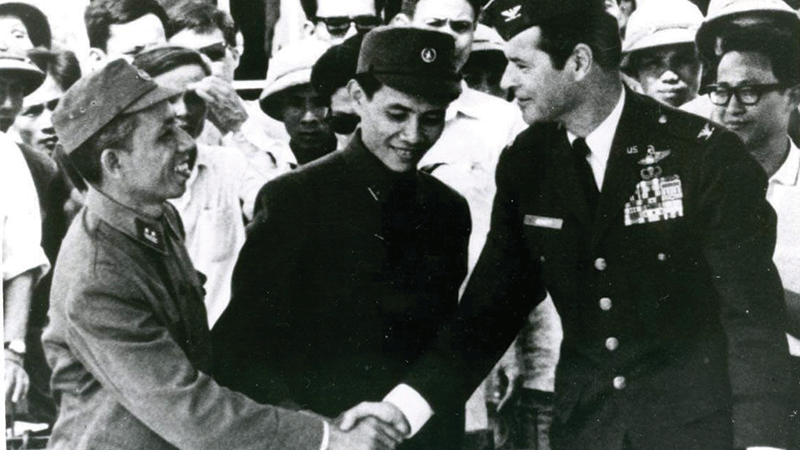 |
| President Thongloun attends a ceremony to hand over pilots whose planes were shot down. |
A glimpse inside the early years of President Thongloun Sisoulith
President Thongloun Sisoulith wrote a letter to his grandchildren to share the experiences of his early years and the strategies he adopted to overcome formidable challenges. His conduct at an early age molded him into a strong, responsible and confident man.
In his recently published memoir, President Thongloun writes about his invaluable legacy, life experiences, and the future he envisioned for Laos while growing up in a remote area against the backdrop of the Indochina war.
Writing this 88-page memoir – “Letter to Grandchildren” - would have been a smooth sail for a professional writer and he would have completed it within a stipulated time. Not for President Thongloun - given his busy schedule and the uniqueness of the times he grew up in.
He took five years to complete this memoir, which is in the form of a letter addressed to his grandchildren.
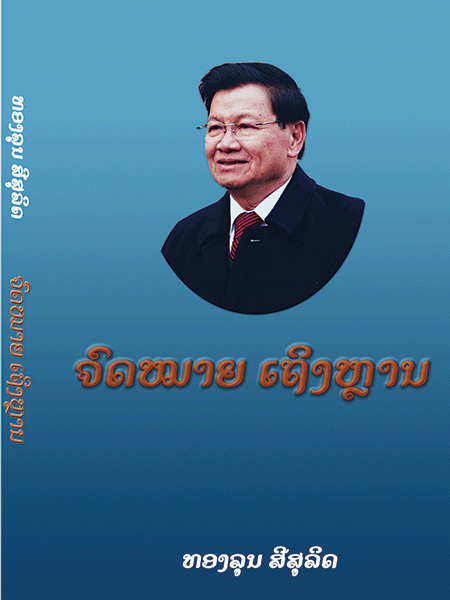 |
| President Thongloun writing a letter to his grandchildren on an aeroplane. |
This is President Thongloun, who is 79, first book. He started writing it on an aeroplane when he was the Deputy Prime Minister and Minister of Foreign Affairs and was at the time travelling to attend a special summit to mark the 25th anniversary of ASEAN-South Korea relations in Busan, 2014.
He finished writing his memoir – again on an aeroplane in 2019. By then, he was the Prime Minister of the country and was heading to Russia for the ASEAN summit in Sochi where he also met with President Vladimir Putin.
I read this memoir which consists of 12 chapters – each focussing on a different aspect of life. His school life, his life as a primary teacher, taking the exams at the secondary teacher training college and his role as a revolutionary official.
In other chapters he dwells on his work assignments, exciting tasks that posed challenges, his life as a student in the Soviet Union, (how iron becomes steel if not shaped) and his eventual graduation from a university in the Soviet Union and the assignment of his new duty. His memoir is brimming with thrilling incidents and I can’t wait to go back and re-read it.
There are a lot of life lessons for young boys and girls who can follow his path and cope with difficult circumstances – be they personal or professional.
President Thongloun was born in a poor family in Nachon village, Sobhao sub-district, Xiengkhor district, Huaphan province in 1945. He had two older brothers and an elder sister and younger sister.
The elder brothers and sister died when they were young. Only his younger sister survived.
Mr Thongloun was born when the belief in occult sciences was supreme. The world had access to electricity, but Laos didn’t have this luxury when the President was growing up in Nachon village.
He began going to school when he was 10 years old. There was no school in Nachon village, so he had to walk several kilometres to reach school. The path to school was not easy either. He had to pass through thick forests and cross the Ma River to reach it. The Ma river is one of the three large rivers of Huaphan province.
More than 20 children from the same village walked to school together, but they studied in different classes. He made friends with two children studying in his class during his first month at school. The three friends walked to school together. This was an unsafe period due to the ongoing war.
President Thongloun’s two friends dropped out during primary school as it was difficult for their families to bear the costs and it was unsafe to send them to school.
Most children dropped out of school within weeks of their joining. However, Mr Thongloun kept going to school – even though it meant he had to walk to school alone. His parents encouraged him to keep on studying.
President Thongloun’s father told him that if he would like to study his parents would support him and encourage him as no one from his village had ever completed their primary schooling.
His parents even offered to walk him to school. They also spoke to his cousins, who lived in Sobhao village, to let him stay overnight on school days. But, President Thongloun refused to stay with his cousins overnight and continued walking to school every morning, returning home late everyday.
He regretted that there wasn’t anyone back home to help his parents with chores. Somehow he took time out to help them collect firewood and grow crops to reduce their burden.
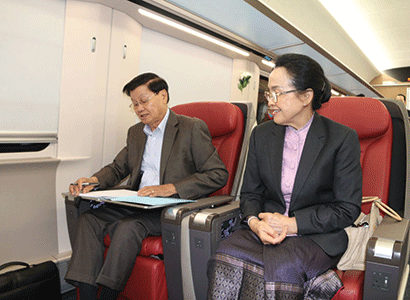 |
On the way to school, he told himself every day: “Life needs to fight and fight for having life.”
This slogan got etched in his mind when he was a young boy. The slogan encouraged him to fight for his life all the time. He has kept on fighting for his life: “Life needs to fight and fight for having life.”
Because of the difficult circumstances at the time, he got inspired to study passionately.
His parents supported him. His mother woke up at 3 am to prepare a meal for him every day. Mr Thoungloun, too, got up early to study by making use of the light that emanated from the cooking stove. All chores were to be completed before 5 am and he had to reach school by 7 am.
He left home early as he had to cross the river. There was a small boat that helped people cross the Ma river. Some days, if the boat was anchored on the other side, he had to swim to get to it.
Indeed, this is an interesting story about President Thongloun’s young life. He encountered many difficulties in his life yet emerged a survivor – especially during the Indochina war.
He was among several young people of the time who had the occasion to help President Kaysone Phomvihane in Huaphan province with important tasks even as the country was striving to get rid of foreign aggressors.
President Kaysone Phomvihane assigned important work to him – such as writing secret documents – and other significant tasks which needed a responsible and reliable person.
At that time, Mr Thongloun was young with little experience yet he did his best to help key leaders. Among other activities assigned to him were: member of the committee to attend the ceremony of handing over five American pilots whose plane had been shot down by Lao Army. A number of these pilots were shot in Vietnam. There were 15 people in all. Most of them were warriors who were sent back home.
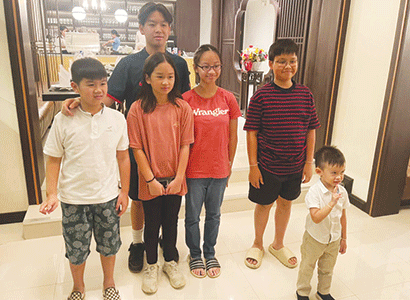 |
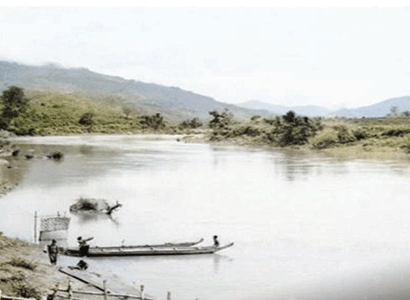 |
| A group photo with President Thongloun’s grandchildren. |
A view of the Ma river in Huaphan province, where President Thongloun used to swim. |
Mr Thongloun was assigned the task of reading the names of these warriors before they were put on a plane.
Mr Thongloun was tasked with attending several activities of the Party at an early age - in both Laos and Vietnam. He worked in Vietnam for several years before he was selected to study in the Soviet Union. At the start of his university life, he found it tough to learn the Russian language, but he didn’t let this get to him. He worked hard and in the end came out in flying colours.
After returning from the Soviet Union, he was assigned a new duty in Vientiane and he married a beautiful girl named Ms Naly. They now have three children and six grandchildren.
The publishers of this book are Ambassador Southam Sakonhninhom and Ambassador Malayvieng Sakonhninhom. Both of them are popular writers. They have authored several interesting books such as “International Law” and “When He Was Prime Minister.”
The publishers said this book will be available in English soon. They are presently working on the translation. Meanwhile, President Thongloun is now all set to write a letter to his children! Can’t wait to read it.
By Phon Thikeo
(Latest Update September 9, 2024)
|






